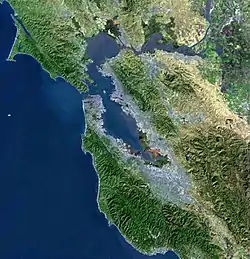San Antonio Creek (Santa Clara County)
San Antonio Creek is a 24.4-kilometre-long (15.2 mi)[2] northwesterly-flowing stream originating on the eastern edge of Santa Clara County just west of its border with Stanislaus County.
| San Antonio Creek | |
|---|---|
| Location | |
| Country | United States |
| State | California |
| Region | Santa Clara County |
| City | San Antonio Valley, California |
| Physical characteristics | |
| Source | Southwest slopes of Mount Stakes in the Diablo Range |
| • coordinates | 37°18′36″N 121°24′54″W[1] |
| • elevation | 3,177 ft (968 m) |
| Mouth | Confluence with Arroyo Bayo to form source of Arroyo Valle |
• coordinates | 37°23′08″N 121°34′21″W[1] |
• elevation | 1,808 ft (551 m)[1] |
| Basin features | |
| Tributaries | |
| • left | Jumpoff Creek |
| • right | Beauregard Creek, Long Gulch |
History
On April 5, 1776, the de Anza Expedition called the area El Cañada de San Vicente as he traversed the west side of San Antonio Valley from north to south.[3] The 1956 Thomas Brothers map spells it San Antone. This spelling mimics the way it is pronounced in common, modern usage by locals. It was spelled San Antone on the 1924 "Mount Boardman, California" U.S. Geological Survey 15-minute quadrangle.[4]
Watershed and course
San Antonio Creek arises at 3,177 feet (968 m) on the southwest slopes of Mount Stakes[5] and descends into the San Antonio Valley. San Antonio Creek's tributaries are, in order heading downstream, Beauregard Creek on the right, Jumpoff Creek on the left, and Long Gulch on the right. Its confluence with Arroyo Bayo[6] forms the source of Arroyo Valle. Arroyo Valle proceeds through Lake Del Valle to join Arroyo de la Laguna thence to Alameda Creek and finally terminates in San Francisco Bay. San Antonio Creek and Beauregard Creek are ephemeral.[7]
Habitat and wildlife
The area includes the San Antonio Valley Ecological Reserve, a 3,282 acre nature preserve created by a Nature Conservancy purchase of land from local rancher, Keith Hurner, and known for its herd of tule elk (Cervus canadensis nannodes).[7][8]
There is not historical evidence of San Antonio Creek, Beauregard Creek or Arroyo Bayo supporting steelhead trout (Oncorhynchus mykiss), although Arroyo Valle was a historical steelhead stream whose "headwaters were full of fish".[9]
References
- "San Antonio Creek". Geographic Names Information System. United States Geological Survey, United States Department of the Interior.
- U.S. Geological Survey. National Hydrography Dataset high-resolution flowline data. The National Map, accessed February 27, 2016
- Pedro Font (1913). The Anza Expedition of 1775-1776: Diary of Pedro Font. University of California. pp. 106–107. Retrieved 2016-02-28.
- Durham, David L. (2000). Durham's Place Names of the San Francisco Bay Area. Clovis, California: Word Dancer Press. p. 153.
- "Mount Stakes". Geographic Names Information System. United States Geological Survey, United States Department of the Interior.
- "Arroyo Bayo". Geographic Names Information System. United States Geological Survey, United States Department of the Interior.
- San Antonio Valley Ecological Reserve Draft Land Management Plan (Report). California Department of Fish and Wildlife. February 2016. Retrieved 2016-02-27.
- "Restoration of tule elk California success story". Billings Gazette. December 6, 2006. Retrieved 2016-02-27.
- Leidy, R.A.; G.S. Becker; B.N. Harvey (2005). "Historical distribution and current status of steelhead/rainbow trout (Oncorhynchus mykiss) in streams of the San Francisco Estuary, California (Alameda County)". Center for Ecosystem Management and Restoration. Retrieved 2016-02-28.
